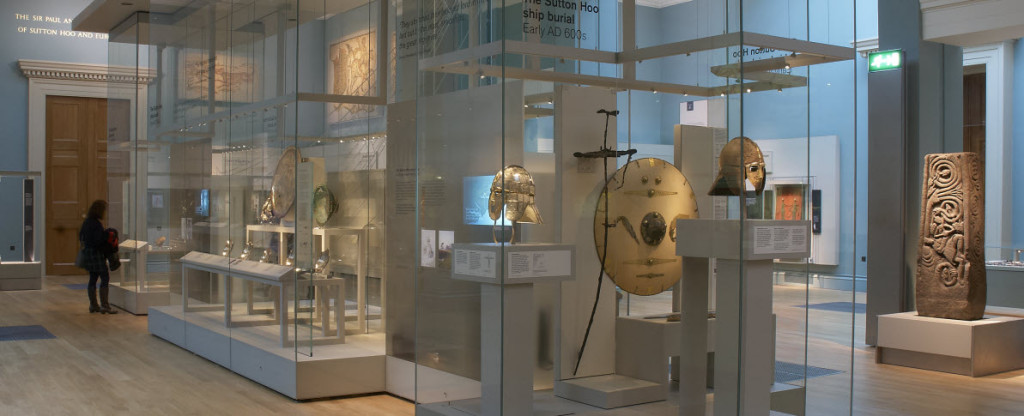In this guest post Dr. Sue Brunning, curator of Insular Early Medieval Collections at the British Museum, reflects on the human story behind the Sutton Hoo ship burial. Dr Brunning will be giving a gallery talk and tour the new Sutton Hoo gallery as part of the Being Human festival on Tuesday 18 November.
Discovery of a lifetime
In 1939, archaeologist Basil Brown made the discovery of a lifetime on a Suffolk country estate: the undisturbed burial of an Anglo-Saxon VIP. Sometime in the early AD 600s, this person had been honoured with a spectacular funeral. A 27-metre-long ship was dragged to the burial ground and a wooden chamber built in its centre. The dead man was laid inside among an array of treasures: Byzantine silver vessels, gold jewellery, sumptuous textiles and gem-encrusted war-gear. The whole thing was covered with a huge earth mound, creating a permanent memorial in the landscape. His body wasn’t found, destroyed by the acidic soil, but the nature of his burial, together with the quality and quantity of its contents, leave no doubt that he was a leading figure in the local Anglo-Saxon kingdom of East Anglia. He may even have been its king.
The face in the helmet
To me, the Sutton Hoo ship burial is so remarkable that it can seem larger than life. It’s hard to believe a living, breathing human being, just like us, was commemorated here; but the objects buried with him help us to connect with him across the centuries. Chief among these is his helmet, a magnificent decorated piece with a haunting human face: eye sockets, a nose, a mouth and even a neat little moustache. Ironically, it’s not just a human face: it’s also a fantastical flying beast. The curved eyebrows are its outstretched wings, the nose its body and the moustache its tail, while its head pokes upwards between the eyebrows. Most visitors I speak to in the gallery don’t see the creature until I point it out. First and foremost they see the human face, because as humans this is what we tend to do.
The man in the ship
The helmet’s face seems to humanise the man in the ship burial, bringing us closest to him. In fact, it’s sort of an illusion: an idealised projection of power, majesty and perhaps even god-like status. This is who he wanted people to think he was, rather than who he truly was. This can make him unreal and otherworldly again, and while we can certainly admire him, we can’t connect with him on a human level. But another object in his grave can help us to do this.
An ornate sword was laid beside the dead man, its hilt (handle) made of gold inlaid with garnet gemstones. Delicate beaded wire used to decorate the hilt is badly worn down. My research into Anglo-Saxon swords has shown that this was probably caused by sword’s owner touching the hilt when he wore it sheathed at his hip. Perhaps he rubbed it habitually, like many of us do with pendants or wedding rings today; or he rested his hand on it as a gesture of authority or self-importance, like standing up straight or putting your hands on your hips. To me, this brings him sharply back to life: while his status was clearly extraordinary, we can see him now as a living person; one who shared little quirks and behaviours that are at the heart of being human.
Communicating these messages to our visitors is one of the best parts of my job, and this is what I will be doing at the Being Human festival of the humanities. Making research and collections ‘human’ is what the festival is all about. I am looking forward to playing my part in doing just that.
The Sutton Hoo ship burial was donated to the British Museum by Mrs Edith Pretty in 1939. It forms the centrepiece of Room 41, the Sir Paul and Lady Ruddock Gallery of Sutton Hoo and Europe AD 300–1100 which opened in March 2014 following a major refurbishment. Admission is free.
The British Museum is one of many museums and research organisations taking part in the Being Human festival. For updates on that programme and on the festival follow us on Twitter @BeingHumanFest, and on Pinterest. Don’t forget to sign up to our e-newsletter, too!

